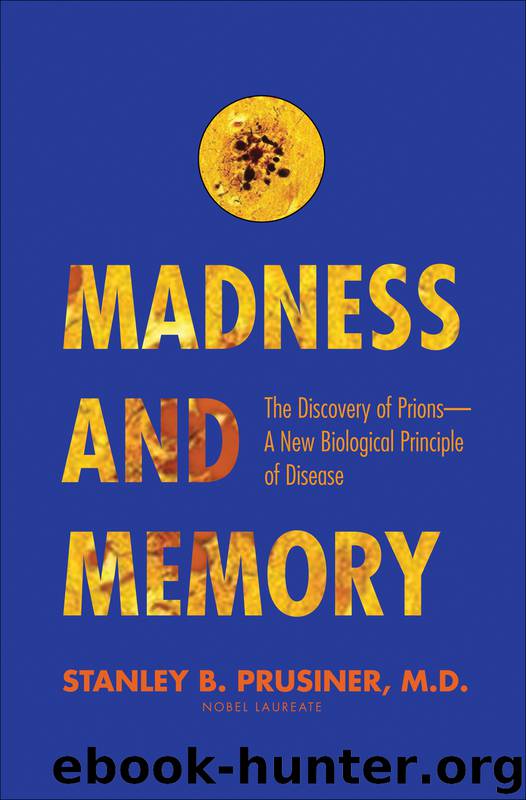Madness and Memory by Stanley B. Prusiner

Author:Stanley B. Prusiner
Language: eng
Format: epub
Publisher: Yale University Press (Ignition)
Published: 2014-03-14T16:00:00+00:00
Slowly, opposition to the prion concept was collapsing. I was particularly happy to get a call from Joe Gibbs in the fall of 1988, asking me to have lunch with him on my next trip to Washington. We met at the Officer’s Club at the Bethesda Naval Medical Center. Gibbs began by saying, “My four young scientists were charged with showing that your work is wrong. Instead, they have reproduced every aspect of your studies.”
“That’s great news. When are you going to publish your findings?”
“Soon. We’ve completed so many studies that we have enough data for four manuscripts. Can you help us find a place to publish?” Since his group had simply confirmed my work rather than broken new ground, Gibbs was concerned that no journal would be interested in publishing the studies.
“I’ll try,” I said, possibly more eager than he was to see this important confirmatory work in print. A few days later, I lobbied the editor of Neurology to look kindly on the studies, and they were eventually published in that journal.8
Nonetheless, the scrapie-virus hunters remained undaunted. Soon after our publication of the PrP mutation and the genetic-linkage study, some of them, including Richard Kimberlin and Bruce Chesebro, began to argue that PrP is a receptor for a ubiquitous virus. They contended that mutant PrP binds the “scrapie virus” with increased affinity, which results in more efficient infection. However, by now many strains of prions had been identified, and the prions of different mammalian species exhibited different host ranges. As the tally of different prions kept expanding, the difficulty of explaining how inherited prion diseases are caused by viruses was becoming overwhelming. The scrapie-virus proponents had to postulate a large array of ubiquitous scrapie viruses, consisting of hundreds, if not thousands, of varieties—yet no one had found even a single scrapie virus, anywhere! The only way out of this predicament for the scrapie-virus hunters was piling on one ad hoc hypothesis after another. At times, I almost felt sorry for them.
Our work was still descriptive. We had not yet managed to penetrate the mechanism of scrapie-prion multiplication. With Michael R. Scott, who had joined my group in 1986 after extensive training in molecular biology with Harold Varmus, I decided that the next step would be to construct mice expressing a hamster PrP gene—or transgene, as it is commonly called (a contraction of “transferred gene”) (figure 27). Mice that carry transgenes are called transgenic, or Tg, mice. We knew, from our own work and that of others, that infectious prions did not readily pass from mice to hamsters and vice versa. If we could abolish this transmission barrier by expressing hamster PrP in mice, we might substantially advance our understanding of prions. Moreover, once such Tg mice had been inoculated with hamster PrPSc, we would also be able to test whatever prions were produced in their brains in nontransgenic mice and hamsters.
The barrier for transmission of prions between hamsters and mice was reminiscent of the “species barrier” described by Iain Pattison in the early 1960s.
Download
This site does not store any files on its server. We only index and link to content provided by other sites. Please contact the content providers to delete copyright contents if any and email us, we'll remove relevant links or contents immediately.
Periodization Training for Sports by Tudor Bompa(8170)
Why We Sleep: Unlocking the Power of Sleep and Dreams by Matthew Walker(6618)
Paper Towns by Green John(5089)
The Immortal Life of Henrietta Lacks by Rebecca Skloot(4525)
The Sports Rules Book by Human Kinetics(4294)
Dynamic Alignment Through Imagery by Eric Franklin(4116)
ACSM's Complete Guide to Fitness & Health by ACSM(3989)
Kaplan MCAT Organic Chemistry Review: Created for MCAT 2015 (Kaplan Test Prep) by Kaplan(3939)
Introduction to Kinesiology by Shirl J. Hoffman(3725)
Livewired by David Eagleman(3683)
The Death of the Heart by Elizabeth Bowen(3551)
The River of Consciousness by Oliver Sacks(3540)
Alchemy and Alchemists by C. J. S. Thompson(3449)
Bad Pharma by Ben Goldacre(3355)
Descartes' Error by Antonio Damasio(3230)
The Emperor of All Maladies: A Biography of Cancer by Siddhartha Mukherjee(3065)
The Gene: An Intimate History by Siddhartha Mukherjee(3047)
The Fate of Rome: Climate, Disease, and the End of an Empire (The Princeton History of the Ancient World) by Kyle Harper(3003)
Kaplan MCAT Behavioral Sciences Review: Created for MCAT 2015 (Kaplan Test Prep) by Kaplan(2936)
